BBMP – SOLID WASTE MANAGEMENT
BBMP – SOLID WASTE MANAGEMENT
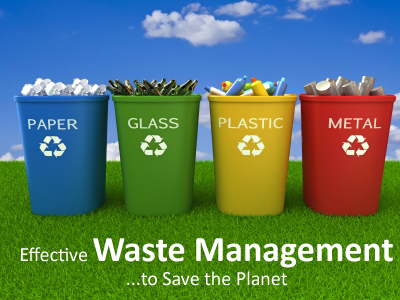
-
Bruhat Bengaluru Mahanagara Palike is spread in 713 Sq. Km Area with total population of 1.3Cr.
- The demography of the city is holding more than 29 Lakh households divided into 8 zones, 27 divisions and 198 wards.
- Eight Zones are:
- Bangalore South
- Bangalore East
- Bangalore West
- Yelahanka
- RR Nagar
- Bommanahalli
- Mahadevapura
- Dasarahalli
- Approximately 58.5% of the city’s waste generation is from households, 49.7% from commercial establishments and 6.8% from street sweeping.
- The Per Capita waste generation from regular households in the city is 309g and that from slums is 300g.
- BBMP has 1700+ Pourakarmikas under the direct payment of ULB who are carrying out cleaning of public places (Streets, Roads, etc.,) and collects street sweeping waste which will be sent for further processing and disposal.
- It has 7 Wet Waste Processing Plants with 1570 Tons Per Day (TPD) Processing Capacity; 13 Bio Methanation Plants with 65 TPD Processing Capacity; 1 Sanitary Landfill with 3000 TPD Intake Capacity.
- BBMP has 4646 primary collection vehicles (auto tippers) and 625 secondary collection vehicles (compactors – big garbage vehicle).
- BBMP has total of 418 toilets which are spread across the city among 8 Zones for citizens in which 401 is Public Toilets and 17 are community toilets.
- BBMP has achieved the certification of ODF & ODF++.
SOLID WASTE MANAGEMENT SCENARIO IN NAMMA BENGALURU
Since 1980s, Bangalore has been charmed to be one of the fastest making metropolitan networks in Asia. The Bangalore Metropolitan zone covers 1258 sq km and is the fifth most fantastic city in India. With a growing number of people and IT zones, local experts are endeavoring to give correct strong waste administration structure to a pleasant level.
The Actual Scenario
- MSW synthesis variety assumes a significant function in the waste management framework. Henceforth, information gathered from the different sources over the year has been investigated. Fig. 1 shows variety in MSW organization from 1999 to 2013 in Bangalore City.
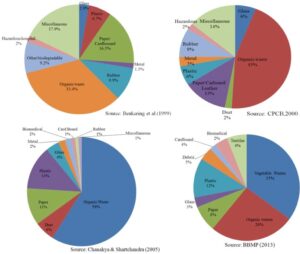
- It was seen that radical expansion in the natural waste from 42% in 1999 to 61% in 2013 might be essential because of increment populace, inappropriate strong waste administration, or green waste collection because of reusing exercises in Bangalore City, a 16% decline in the paper, cardboard, and leather wastes.
- Interim, it was additionally noticed a significant expansion in plastic wastes in 2007, which may be because of the urbanization and expanded utilization of plastic convey packs. Notwithstanding, in 2013, the level of plastic waste was diminished to 7%, which might be inferable from the successful boycott of plastic communicate sacks beneath 40microns inside city limits in 2012.
- The metals, rubber, and glass were discovered to be less in the waste composition, demonstrating the diminished utilization of glass and metal items and viable reusing of glass and metal items by isolation at sources themselves.
Disposal practice in Bangalore:
- Bangalore doesn’t have any logical treatment strategy facilities for solid waste produced by municipal and industries around Bangalore.
- This has provoked the headway of a couple of illegal and unapproved dump objections in Bangalore.
- The region of unapproved dump regions in and around Bangalore city is as showed up in Fig. 2. Fig. 3 shows the territory of these dumpsites close by wards and their breaking point in Bangalore city. Fig. 4 shows the road network nearby dump destinations in and around Bangalore city.
Fig. 2 – Location of unauthorized dump sites in and around Bangalore city
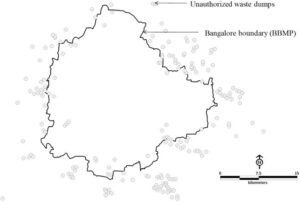
Fig. 3 – Unauthorized dumping along with wards in and around Bangalore city.
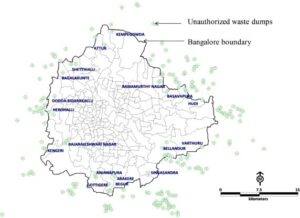
Fig. 4. Major Arterial and sub arterial road network along with dump sites in and around Bangalore city.

Current development in Bangalore:
- The waste objections which were earlier in the edges of the company furthest reaches of Bangalore city are presented in the headway zone of more unmistakable Bangalore city as showed up in Fig. 5.
Fig. 5. Location of unauthorized dumping site in greater Bangalore city map
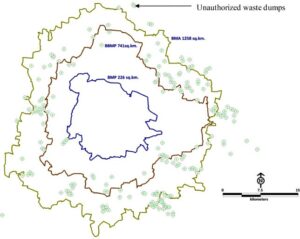
Current practice of handling and disposal:
- Presently, Bangalore has 198 wards; Bruhat Bangalore Mahanagara Palike (BBMP), the office vested with the obligation of removal of solid waste, is occupied with different endeavors to give a compelling SWM framework to the city, fusing a progression of approaches.
- For a more profitable and beneficial strategy, the city has been isolated into different definitive units, the humblest of which is the health ward; as of now, there are 294 health wards inside the BMP structures.
Collection:
- BBMP administers about 30% of MSW and 70% of MSW action; beginning from essential assortment to removal has been reevaluated. The variety of waste is done in two phases. The starter stage is a prompt assortment, wherein the waste is assembled on auto tipper and wheelbarrows. An Auto tipper has been obliged for every 1000 family units and a truck for every 200 families. Around 20,000 pourakarmikas are being utilized (both BBMP and legally binding specialists) in the house-to-house assortment, street clearing, and MSW transportation.
- The waste assembled from the families is brought to a run of the mill point, i.e., discretionary zones from where the waste is moved to landfill areas/treatment through tipper Lorries and compactors.
- This action is dispensed to Self Help Groups (SHG’s), which are generally underneath destitution women’s social affairs. BBMP has administered 3197 pourakarmikas (Sweepers) and 18,562 pourakarmikas from a transitory specialist who plays out a house-to-house assortment and clearing exercises. Yearly, around 250 crores are spent on waste administration, i.e., BBMP pourakarmikas pay, contract installment, tipping charges.
Transportation:
- Transportation of waste from assortment focuses on the last removal site/landfill is essential in waste administration. As of now, waste transportation uses pushcarts, auto, etc., which carry the waste to critical collection centers. From that point, trucks gather waste and transport it to landfill.
- In Bangalore alone, 4500 tons of waste are generated every day, including household waste as well as industrial, hospital, commercial and construction waste. It can be said that Bangalore can process about 2100 tons of municipal waste every day.
- Mavallipura waste disposal capacity is 600 t/d, Karnataka Composting Development Corporation Ltd (KCDC) is 300 t/d, and Terra Firme is 1500 t/d. The remaining waste will be dumped in Bingipura and Lakhimpura.
- Bingipura and Laxmipura didn’t have a handling unit, and as it was a quarry pit zone, it was utilized to fill. In any case, presently, it is over-burden and quit unloading. Because of dumping and garbage burning to sicknesses like asthma, heart attack and so forth.
PROBLEM WITH THE EXISTING WASTE MANAGEMENT SYSTEM
Rather than giving arrangements, improve the waste management situation in Bangalore city. In Bangalore, roughly 60% of household waste is collected, and just 15% experience treatment and handling. Because of escape clauses in existing waste management systems and the absence of mindfulness among the network. Indeed, even the waste that is collected is generally not segregated. The onus of these doesn’t fall alone on the community and on the contractual workers responsible for collecting and transporting the wastes. To boost their benefit and lessen transportation costs, they not exclusively don’t segregate the wastes collected by them yet additionally illegally dump them into unapproved areas.
LEGAL REGULATIONS IN PLACE FOR MANAGING SOLID WASTES
The Ministry of Environment, Forests and Climate Change (MoEFCC) has advised a progression of guidelines for overseeing different waste classifications like plastic, hazardous wastes, construction and demolition wastes, and solid wastes, and so forth Out of that, Solid Waste Management (SWM) rules, 2016, this was informed in 2016 and supplanted the past Municipal Solid Wastes (Management and Handling) Rules, 2000.
- Solid waste management rules, 2016 rules must be enforced and promote several critical aspects of scientific disposal methods of wastes.
- It enforces the source segregation of waste into three categories, namely, organic wastes (kitchen wastes), dry wastes (like paper, plastic, etc.), and domestic hazardous wastes (like mosquito repellant cans, etc.) before handing over solid wastes to the pourakarmikas (waste collectors).
- It is mandatory to set up a proper disposal mechanism for sanitary waste that has been given to sanitary products’ manufacturers.
- Also, it enforces for hotels and restaurants are mandated to set up a system for ensuring the proper disposal of food wastes.
- Municipality must be empowered to charge the fees for collecting and disposal of solid wastes from the waste generating community and spot fines for deviance against the mandates of SWM, rules 2016.
- Develop provisions for promoting a proper market infrastructure for eco-friendly waste disposal mechanisms like composting, bio methanation (etc.). Also, encourage by giving incentivize these mechanisms.
- To monitor the implementation of these rules, the government set up the central monitoring committee, under the Secretary’s chairmanship, MoEFCC, and comprising of stakeholders from the center and the states.
ISSUES IN THE IMPLEMENTATION OF SWM RULES
In extra SWM rules, 2016 feature the significant issues and escape clauses of the waste management system. Nonetheless, some principal obstacles have turned out in the effective implementation of these rules.
- Limited number of staffs: Many cities lack sufficient staff to address the problem of waste disposal. These workers often have to deal with waste management emergencies. The limited number of these employees makes long-term planning and strategic development difficult.
- Political Turmoil: Changes in administration will result in closure or radical modification of existing waste management comes by reassigning officers and new workers. The technical staffs who helped create the projects a reality didn’t get an opportunity to remain till the tip of the projects. The continuity of employees helps within the swish management of solid waste management projects.
- Lack of planning: The lack of planning at the national and local levels has not led to such success in solid waste management; subsequently, municipal planning to implement the plan was ignored. Waste treatment projects are usually handled by multiple ministries/departments. The lack of coordination caused the project to fail. Coordination between different government agencies or departments can help create a holistic system.
- Difficult working conditions of workers dealing in solid waste: In developing countries, staff with solid waste management are paid less and have less coaching. while not correct training and private protecting equipment, these workers are at risk of injuries or diseases at work. Studies have shown that a high share of individuals concerned in waste management or people living close to disposal sites are in danger of being infected by worms or parasites. staff don’t have the motivation to figure hard, so that they quit early. Lack of coordination with numerous stakeholders is resulting in outlawed dumping, improper waste segregation and things are becoming dangerous to worse.
- Waste burning: The burning of solid waste leads to the emission of particles that are making a element of stuff which incorporates a vital impact on regional air. methane series gas is emitted from waste deposits that facilitate within the formation of ground-level ozone. Also, methane may be a greenhouse emission that causes climate change.
- Financial constraints: Many cities do not have enough financial resources to dispose of such a large amount of solid waste. The city is responsible for handling such a large amount of garbage, but the city does not have enough financial resources to properly manage this garbage.
- Limited technical skills in equipment handling: If the equipment is not designed for local conditions, these tools may require frequent maintenance, and some parts may be difficult to find. In tropical regions, local conditions such as humidity and heat usually affect equipment performance. Local governments often lack the expertise to evaluate technologies or solutions to determine which is best for their situation. Difficulties arise when a private company signs a contract with a city to provide technology or implement a project, but if the city fails to meet the contract terms and abandons the project.
- Role of the informal sector: The informal sector is a very important stake holder cluster to contemplate associate degree embody throughout specific steps whereas designing a solid waste management program. In general, the informal sector thought of individuals, groups, and little businesses that perform informal waste services involving the gathering and sale of recyclables, sometimes to middleman or intermediaries. Employees earn financial gain by commerce the recyclables they collect to a network of dealers and usage industries that employment at intervals the formal non-public sector. This sector will play an outsized role in separating materials and crucial what waste are going to be collected.
- Limited available land: As urban areas and populations still grow, the quantity of obtainable house for solid waste facilities, local assortment locations, and transfer stations decreases. There might not be space, the available parcel of land is also too expensive, and native residence might forestall facilities from being developed because of worry of smell depreciative their living condition property prices. However, setting these facilities at a distance from cities, wherever land is a lot of available and fewer expensive, creates a brand-new set of challenges as a result of howling waste long distances is long and expensive.
CONTROL MEASURES OF WASTE
- Fees to be paid by the generator of the waste: If we can bill the generators (both household and bulk generators like hotels, shopping malls, hospitals, etc.) by volume of waste, then on the one hand, it is possible to reduce the voluntary production waste and collect income. by local urban authorities.
- Segregation of waste at the source: Segregation of waste at source reduces waste collection costs and can be correctly transported or deposited at specific waste recycling agencies for low-cost recycling.
- The recycling bio methanation process can be successfully used for biodegradable waste. In addition, if necessary, other composting techniques can be used to treat biodegradable waste.
- Should stop littering and recommend fines on the spot.
- Enforcement of solid waste management regulations in 2016 and revision of regulations accompanying this.
- The integration and mapping of stakeholders are a must: waste management is successful when there is strong integration of local governments, mass waste generators, NGOs (NGOs), community groups, academia, etc., assuming stakeholders are resident.
- Strong community involvement in raising awareness about the harmful effects of waste and managing this waste for wealth creation is essential. Local governments, municipalities, non-governmental organizations, and academia can ensure this awareness and participation of the entire community.
Bangalore needs a foolproof and comprehensive system to manage the solid waste generated. The waste management system should not only have an essential and decentralized garbage disposal mechanism. Still, it should also have a strict monitoring mechanism for the implementation of solid waste management rules. BBMP should be given authority to impose stringent penalties upon those who would defer from the rules.
- Awareness campaigns should be employed to motivate community participation in the disposal of wastes and health. The economic wellbeing of the waste picking informal community should be taken care of.
- For achieving environmental sustainability, “reduce and reuse” for recyclables wastes (i.e., non-biodegradable wastes like paper, plastic) for further use and reduction of organic waste disposal.
- Plastic wastes are left untreated in Bangalore. These plastic wastes either rested in open dumps or landfills or drainage systems, thereby clogging them, leading to runoff and seepage of the contaminated drain water into neighbouring locality and plastic burning releases dioxins gas. Recycling plastic may not always technically and economically feasible. However, plastic waste can be reused for laying of roads.
- Eco-friendly approaches should be implemented for organic waste. Some of these methods include vermicomposting (which involves the decomposition of the organic matter, in the presence of oxygen, with microorganisms or worms that help produce a humus-rich soil conditioner, also known as compost. These can be used in organic farming), bio methanation (which is essentially a biochemical method of organic wastes to methane-rich biogas, which can in turn be used as fuel), etc.
- Appropriate legislation should be framed to delegate greater power and autonomy to urban local bodies, particularly in resource mobilization. The urban local bodies are the principal stakeholders in the waste management system in Bangalore. Yet, they suffer from a lack of adequate finance and appropriate government support at the central and state levels.
-
A significant portion of the municipal expenditure on waste disposal and management goes into collecting and transportation waste, leaving very little finance to treat them effectively. In this respect, appropriate financial interventions on the center and the state governments and providing suitable subsidies for the promotion of more and more eco-friendly waste disposal measures will go a long way in addressing the issue of the garbage ‘pandemic’ in our country.

